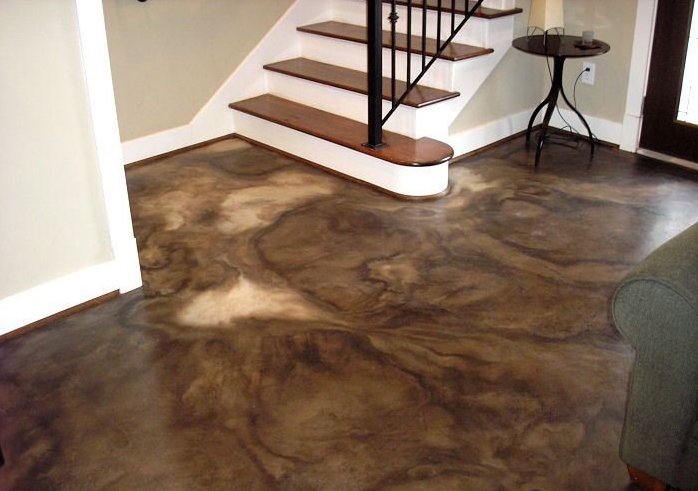Acid-staining concrete floors are a popular way to add color and character to a space, and it is a cost-effective alternative to traditional flooring materials such as wood, tile, or carpet. Acid staining is a chemical process that reacts with the minerals in the concrete to create a mottled, marbled, or variegated finish, and it can be used to create a range of looks, from rustic and industrial to modern and sophisticated. If you are considering acid staining your concrete floors indoors, here are a few steps to follow.
The first step in acid-staining concrete floors indoors is to prepare the installation area. This may involve removing any existing flooring or fixtures, such as baseboards or thresholds, and repairing any damages or imperfections in the concrete. It is also important to ensure that the concrete is clean, dry, and free of any coatings or sealers, as these can affect the final color and finish of the acid stain.
The next step in acid staining concrete floors indoors is to apply the acid stain. Acid stains are available in a variety of colors and finishes, and it is important to choose a stain that is suitable for the type of concrete and the desired look. Acid stains should be applied according to the manufacturer’s instructions, using a brush, roller, or sprayer, and it is important to wear protective clothing and equipment to avoid contact with the skin and eyes.
After the acid stain has been applied, the next step is to neutralize the acid. Neutralizing the acid helps to stop the chemical reaction and prevent further etching or discoloration of the concrete. Neutralizing solutions are available at most home improvement or flooring stores, and it is important to follow the manufacturer’s instructions for application and dilution.
After the acid has been neutralized, the next step is to rinse and clean the floor. Rinsing and cleaning the floor helps to remove any excess acid or neutralizing solution and prepare the surface for sealing. It is important to use a mild detergent and plenty of water to thoroughly rinse and clean the floor and to allow the floor to dry completely before proceeding to the next step.
And the last step in acid staining concrete floors indoors is to apply a sealer. A sealer is a protective coating that helps to protect the acid stain from wear, moisture, and UV radiation, and it can help to enhance the color and finish of the floor. There are several options for concrete sealers, including water-based and solvent-based, and it is important to follow the manufacturer’s instructions for application and maintenance.
How To Acid Stain Concrete Floors Indoors

How to Apply an Acid-Stain Look to Concrete Flooring HGTV
Staining A Concrete Floor Is Easy, Just Follow Our Step By Step
How to Acid Stain Concrete Floors u2022 The Prairie Homestead
Concrete Stain
Acid-Stained Concrete Flooring Maintenance: Furniture Placement
How to Acid Stain Concrete Floors u2022 The Prairie Homestead
Styles of Stained Concrete Floors u2014 Craftsman Concrete Floors
Stained Concrete Floors: Cost, How to Stain DIY, Maintenance Tips
How To Acid Stain Concrete Floors – Create Easy Care Floors With
Acid Stained Concrete Offers Rich Color – Concrete Network
How To Acid Stain A Concrete Floor
Acid Stain Concrete American Concrete Polishing u0026 Coating
Why this Water-based Concrete Stain is Better than Acid All
Related Posts:
- Acid Wash Concrete Floor Colors
- Concrete Floor Thickness For A Garage
- Concrete Floor For Bathroom
- Interior Concrete Floor Ideas
- Kitchen Stained Concrete Floors
- Concrete Floor Tile Thickness
- How To Stain Concrete Floors DIY
- DIY Concrete Floor Grinding
- Concrete Floor Damage
- Faux Stained Concrete Floors












